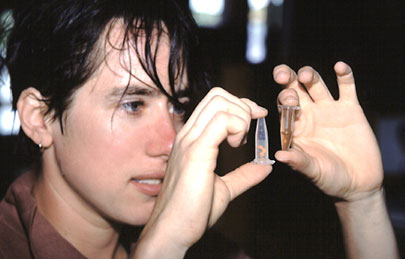Maps that aid marine conservation
Maps that aid marine conservation McGill University
User Tools (skip):

Sara Lourie, a research associate at the Redpath Museum, examines specimens of new species of pygmy seahorse—the world's smallest known seahorse - in Indonesia.
Joerg Adam
Maps that aid marine conservation
In the July 2 issue of BioScience, researchers and conservation practitioners from 12 organizations presented the Marine Ecoregions of the World (MEOW), adding 232 coastal marine units to the 825 units on land. Dr. Sara Lourie, a research associate at the Redpath Museum, was invited as a co-author based on her extensive knowledge of worldwide marine conservation planning, specializing in biodiversity in South-East Asia, sea-horses in particular.
"The beauty of the MEOW framework is that it provides a consistent, reliable tool for setting priorities in conservation decisions," says Dr. Lourie. "In a way, mapping for conservation is beginning to reflect biodiversity itself."
Mapping initiatives such as MEOW are breathing life into the fundamental, but often unappreciated, sciences of taxonomy (species) and biogeography (distributions), explains Lourie.
"Even as biodiversity is becoming a household word, the small number of people who are trained in taxonomy, natural history, and the basics of biodiversity is declining rapidly," says Lourie. "I believe that the average age of taxonomists is about 60."
Seahorses as conservation flagships
Lourie is an active partner of Project Seahorse, an international collaboration of biologists, social workers, and other practitioners whose mission is to conserve seahorses and the habitats in which they live while respecting the needs of the humans who depend on them.
Seahorses have been used for human purposes for centuries. During fieldwork for her doctoral thesis, Lourie learned that seahorses are common in remedies for respiratory and urinary ailments. They are tied to small fishing boats or hung on walls as good luck charms. Seahorses are also an alleged aphrodisiac. Like many other species, seahorses are in need of protection.
Seahorses are collected in very large numbers, and are declining in number around the world. This is partly because of direct capture for human use, but primarily because they end up as by-catch in commercial ships trawling for fish.
"Seahorses are just one charismatic example of many species damaged in the commercial fishing process," says Lourie. "Ecoregions ought to be recognized by all countries, so that endangered fish populations can be adequately protected, even where they roam across political boundaries."

